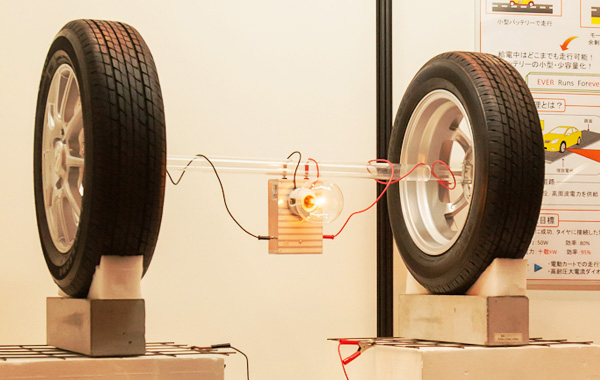Powering the battery on a car with an electric motor and battery pack usually requires plugging in at night and sometimes during the day. Other options exist as well, such as solar panels on vehicles and regenerative braking, but none can fully satisfy the energy needs to maximize your driving range daily. Now another methodology has come along from Toyohashi University of Technology in Japan that involves a power transfer from the wheels to power an EV.

According to the university, this method developed by researcher Takashi Ohira and his colleagues reportedly would allow an electric car to actually make use of less batteries. As Ohira explains it,
The approach exploits the steel belt usually embedded in rubber tires. The steel belt collects power excited from a pair of electrodes buried beneath the road surface. And, since the steel belt is electrically insulated by the rubber tread, the researchers used a displacement current at high frequency to penetrate from underground to the steel belt.
The researchers constructed a 1/32 scale EV to proof their concept for the electric car. The car moved successfully with a power penetration efficiency exceeding 75% at 52 MHz.
The results of this research were recently published in the IEEE MTT-S International Microwave Workshop Series on Innovative Wireless Power Transmission. The abstract tied to the paper these findings got mentioned in notes:
The scheme is called Tire Dielectric Coupling. We designed and prototyped the feeding subsystem using 1/32 scale models. The feeding subsystem is constructed of metal plates, tires and steel belts. We measured S-parameter of the feeding subsystem. As results, S11 is -0.06 dB and S21 is -30.3 dB. With the S-parameter, we built an equivalent circuit model of the feeding subsystem at a wide frequency range in VHF band. We designed and prototyped impedance matching circuits based on an equivalent circuit technique. After tuning, measured S21 of the feeding subsystem with the impedance matching circuits achieved -1.2 dB. This result is as high efficiency as charge/discharge efficiency of lithium-ion battery.
This tire dielctric coupling, if taken to a production level scale, could go a long way in helping address some of the stumbling blocks around electric cars in the eyes of many, which include short cruising range, long time to recharge and high cost.
“If the scheme is applied into practice, we believe it would enable a tremendous extension of the EV cruising range,” said Ohira in a statement.